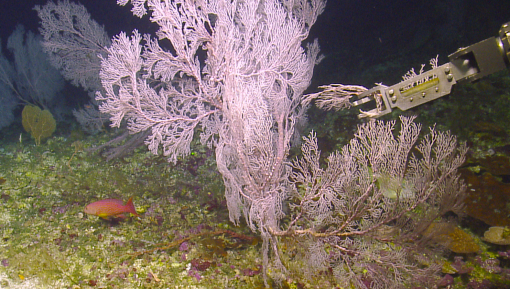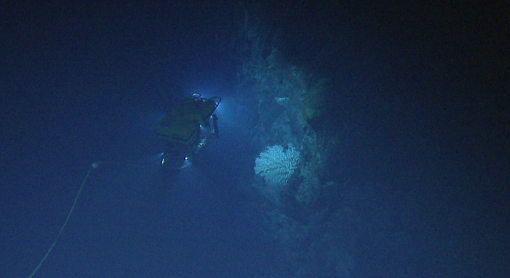Exploring Deepwater Regions of Baker and Howland Islands and Johnston Atoll

The Pacific Remote Islands National Marine Monument is one of the largest marine conservation areas in the world, encompassing seven national wildlife refuges on coral islands, reefs, and atolls. The main objective of this expedition from August 25 to September 16, 2019 is to collect deepwater baseline information to support science and management decisions in and around U.S. marine protected areas in the central Pacific, including Baker and Howland Islands and Johnston Atoll. We will conduct seafloor mapping and acquire video, biological, chemical, and geological samples to better understand marine habitats, biogeographic patterns, seafloor mineral distribution, and the geologic history of these areas. This Nautilus expedition is sponsored by NOAA Office of Exploration and Research, with participating organizations including U.S. Fish and Wildlife Service, Temple University, University of Rhode Island, and Marine Conservation Institute.
Corralling Critical Coral Communities
The five regions of the Pacific Remote Islands National Marine Monument (PRIMNM) cover 495,189 square miles and span the Central Pacific Ocean from Wake Atoll in the northwest to Jarvis Island in the southeast. The Monument was designated in 2009 to protect coral reefs, seamounts, and marine ecosystems within 50 miles of these islands and atolls from commercial fishing and other extraction activities, such as seafloor mining. In 2014, the PRIMNM boundaries around Wake and Jarvis Islands and Johnston Atoll were expanded to the extent of the Exclusive Economic Zone (200 miles offshore) to further protect deep water coral habitat around seamounts as well as pelagic habitat and forage areas for a wide variety of fish, seabirds, and sea turtles.
The hard, sloping substrates of seamounts, islands, and atolls and the currents which flow over them offer rich habitat for colonies of filter-feeding deepwater corals and sponges. These vibrant coral communities are abundant with life, providing attachment sites, nursery habitat, spawning areas, and refuge from predators for a variety of deep-sea species.
Seeking the Geologic History of the Seafloor
The seafloor within the boundaries of the PRIMNM generally formed during the Cretaceous period, 145 to 66 million years ago. Geologic age of a seamount can only be determined by geochemical analyses and basalt dating techniques of collected samples, and Nautilus samples will help contribute to our understanding of this area’s geologic history. The flanks and summits of these seamounts, islands, and atolls have become encrusted with cobalt-rich ferromanganese deposits, which form slowly over millions of years through deposition of iron oxide-hydroxide and manganese oxide on a sediment-free substrate. Other metals deposited on the crust surfaces may include valuable minerals such as molybdate, cobalt, copper, nickel, and tellurium.The Johnston Atoll Unit lies within an area of the Pacific with the highest concentration of commercially valuable deep-sea minerals, known as the Prime Crust Zone. The Howland and Baker Islands Unit spans an area favorable for ferromanganese crusts as well as polymetallic nodules.

Beyond CAPSTONE with Nautilus Exploration
Between 2015 and 2017, NOAA conducted a Campaign to Address Pacific monument Science, Technology, and Ocean Needs (CAPSTONE). During this campaign, portions of the Howland and Baker Units and the Johnston Atoll Unit were mapped and explored by NOAAS Okeanos Explorer cruises in 2015 and 2017, and an R/V Falkor cruise in 2017 mapped portions of the Johnston Seamounts, however this vast area is still largely unexplored. Highlights of the Okeanos Explorer expedition in 2017 near Howland and Baker Island included steep slopes characterized by dramatic geologic formations with cathedral-like arches and overhangs and high-density coral communities attracting diverse fish species. Previous Johnston Atoll exploration investigated newly-mapped seamounts, manganese-encrusted seafloor habitats, and precious coral and sponge communities.
This Nautilus expedition will build upon this foundational science initiative and continue to gather information about the topography, geology, and biology of this important United States territory and the surrounding areas. Mapping operations will focus on adding coverage to existing mapping data, conducting surveys to support ROV dive site planning, and mapping uncharted areas during transits. Geological collections will help define substrate type and refine age estimates for the features explored in this geologically complex region. Biological specimens will help define biogeographic boundaries, depth distribution and diversity of species, and observe the basic biology and ecology of these ecosystems, compared to other regions. In addition, the video collected will be used for diversity estimates, frequency, and fidelity of coral-associated communities, knowledge critical to evaluating the impact of the Marine Protected Areas on deep-sea ecosystems over time.
While maritime archeology is not a major focus of this expedition, there is a possibility of encountering artifacts from shipwrecks. Within PRIMNM boundaries of the Howland and Baker Islands Unit and the Johnston Atoll Unit, no deepwater wrecks have been discovered, but at least 10 wrecks occurred in the vicinity of Howland Island and 13 near Baker Island during guano mining operations between 1859 and 1871. Any encounter with artifacts from shipwrecks will be documented with video. Additional expedition activities include deploying several weather and wave buoys while in international waters, and delivering supplies to remote Kanton Island in the Republic of Kiribati.

Expedition Objectives
- Acquisition of high-resolution bathymetry in areas where no or patchy mapping data exists. Priority targets include seamounts, guyots, ridges, and margins around atolls and islands. This data will support the GEBCO Seabed 2030 initiative to map the world’s seafloor by 2030 in areas that are remote and would likely remain unmapped.
- Exploration and characterization of the density and diversity of benthic habitats, including deep-water corals, sponges, and fish habitats on seafloor features throughout the U.S. Exclusive Economic Zone. High-density and high-diversity deep-water sponge and coral communities are of special interest.
- Exploration of seamounts in international waters between these two units may yield a more complete picture of biogeographic patterns in the Central Pacific, and may add to our understanding of the impact of fishing activities on seamounts.
- Exploration of geological structure of seamounts and sampling of basalt from seamounts for subsequent dating through geochemical analyses.
- Identification of benthic communities potentially present on mineral crust zone seamounts in the north and equatorial central Pacific.
- Acquisition of other physical and chemical data in support of conservation and exploration goals for remote units of the Pacific Remote Islands Marine National Monument, including dissolved oxygen and eDNA samples.
Sampling operations will primarily target the following:
- Deep-water corals, sponges, and associated organisms; rock pens (octocorals of the order Pennatulacea which are adapted to cling to hard substrates) are of special interest
- Other biological specimens for potentially new species, range extensions, connectivity; scoops of coral rubble which may harbor invertebrates are of special interest
- Rock samples to identify mineral crusts and date geologic featuresNiskin bottle water samples for environmental DNA and possible seawater carbonate analysis
Expedition Tools and Technologies
ROV Hercules and ROV Argus
EM302 multibeam sonar
Knudsen sub-bottom profiler
During transits in international waters, several instruments will be launched including:
- Two Scripps Institution of Oceanography wave buoys (wave parameters, sea surface temperature, course and speed over ground)
-
Three Sofar Spotter buoys (wave parameters and wind speed and direction)

Baker and Howland Islands and Johnston Atoll
The main objective of this expedition is to collect deepwater baseline information to support science and management decisions in and around U.S. marine protected areas in the central Pacific.





